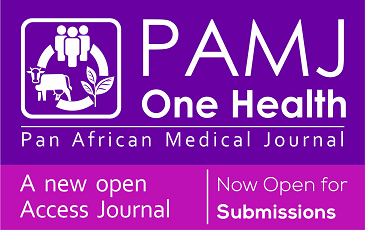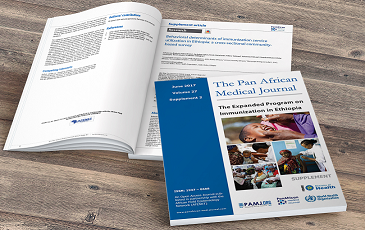Evaluation of patients’ satisfaction after laparoscopic surgery in a tertiary hospital in Cameroon (Africa)
Jovanny Tsuala Fouogue, Robert Tchounzou, Florent Ymele Fouelifack, Jeanne Hortence Fouedjio, Julius Sama Dohbit, Zacharie Sando, Emile Telesphore Mboudou
Corresponding author: Jovanny Tsuala Fouogue, Douala Gynaeco-Obstetric and Pediatric Hospital, Douala, Cameroon 
Received: 18 Dec 2016 - Accepted: 28 Oct 2017 - Published: 08 Nov 2017
Domain: Clinical medicine
Keywords: Laparoscopy, surgery, patients, satisfaction, gynaecology
©Jovanny Tsuala Fouogue et al. Pan African Medical Journal (ISSN: 1937-8688). This is an Open Access article distributed under the terms of the Creative Commons Attribution International 4.0 License (https://creativecommons.org/licenses/by/4.0/), which permits unrestricted use, distribution, and reproduction in any medium, provided the original work is properly cited.
Cite this article: Jovanny Tsuala Fouogue et al. Evaluation of patients’ satisfaction after laparoscopic surgery in a tertiary hospital in Cameroon (Africa). Pan African Medical Journal. 2017;28:216. [doi: 10.11604/pamj.2017.28.216.11441]
Available online at: https://www.panafrican-med-journal.com/content/article/28/216/full
Original article 
Evaluation of patients’ satisfaction after laparoscopic surgery in a tertiary hospital in Cameroon (Africa)
Evaluation of patients' satisfaction after laparoscopic surgery in a tertiary hospital in Cameroon (Africa)
Jovanny Tsuala Fouogue1,&, Robert Tchounzou1, Florent Ymele Fouelifack2, Jeanne Hortence Fouedjio3, Julius Sama Dohbit3, Zacharie Sando3, Emile Telesphore Mboudou1,3
1Douala Gynaeco-Obstetric and Pediatric Hospital, Douala, Cameroon, 2Higher Institute of Medical Technology, Yaounde, Cameroon, 3Faculty of Medicine and Biomedical Sciences of the University of Yaounde I, Yaounde, Cameroon
&Corresponding author
Jovanny Tsuala Fouogue, Douala Gynaeco-Obstetric and Pediatric Hospital, Douala,
Cameroon
Introduction: access to laparoscopy is low in Cameroon where customers' satisfaction has not been reported so far. We assessed patients' satisfaction with the process of care during laparoscopic surgery in a new tertiary hospital.
Methods: a questionnaire was addressed to consenting patients (guardians for patients under 18) with complete medical records who underwent laparoscopy at the Douala Gynaeco-Obstetric and Paediatric Hospital (Cameroon) from November 1, 2015 to July 31, 2016. The following modified Likert's scale was used to assess satisfaction: very weak: 0-2.5; weak 2.6-5; good: 5.1-7.5; very good: 7.6-10. Only descriptive statistics were used.
Results: response rate was 90% (45/50). Of the 45 respondents, 39 (86.7%) were female, 14 (31.1%) were referred and 39 (86.7%) paid by direct cash deposit. Mean age was 36.8±11.9 years. Laparoscopies were carried out in emergency for 3 (6.7%) patients. Digestive abnormalities indicated 13 (28.9%) laparoscopies while gynaecologic diseases accounted for 32 (71.1%) cases. Perception of the overallcare process was good with a mean satisfaction score of 6.8 ± 1.4. Scores in categories were: 0% (Very weak); 13.3% (weak); 57.8% (Good) and 28.9% (very good). Specifically, mean satisfaction scores were: 7.8 ± 1.0 with doctors' care; 7.1 ± 1.3 with hospital administration; 7.0 ± 1.2 with nursing and 4.7 ± 1.4 with the costs. Main complaints were: long waiting time (73.3%), constraining geographical access (66.7%) and expensiveness (48.9%).
Conclusion: patients were globally satisfied with the process of care but financial and geographical barriers should be addressed.
Over the past two decades, patients' satisfaction (PS) has emerged as an important indicator of health care quality [1,2]. PS can relate to the outcome of care (treatment) and/or to the perception of the process of care [3]. This applies to surgical care but is particularly true for laparoscopic surgery which has been proven to be superior to traditional open surgery in terms of minimal perioperative morbidity, lower overall costs, better cosmesis, reduced blood lost, reduced postoperative pain and hospital stay duration, with consequent quick postoperative recovery [4,5]. Laparoscopy has been introduced in Cameroon in 1992 and is currently practiced in five public and eight private hospitals [6-11]. To the best of our knowledge, no study has evaluated the satisfaction of patients with the process of care during laparoscopic surgery. In general, few studies have evaluated patients' satisfaction with health care in Cameroon, while it is a routine activity in developed countries [12,13]. In view of improving the process of care for patients undergoing laparoscopic surgery in Cameroon, we assessed their satisfaction in a tertiary hospital one year after its opening.
Study design and site: we carried out a cross-sectional study at the Douala Gynaeco-Obstetric and Paediatric Hospital (DGOPH). This hospital was opened in September 2015. It is the largest health facility dedicated to mother and child's care in Cameroon (central Africa).
Sampling and procedure: our sample was convenient. We consecutively included all consenting patients (legal guardians for those under 18) who underwent laparoscopic surgery from November 1, 2015 to July 31, 2016. Patients with incomplete medical records were excluded. Data were collected through a self-administered questionnaire on the following items: doctors' care, nursing, administrative procedures and cost. Participants were also asked to list their main complaints. Following a modified Likert's scale, participants were asked to score their satisfaction from 0 to 10 ("very weak": 0-2.5; "weak" 2.6-5; "good": 5.1-7.5; "very good": 7.6-10). Then a technical form was used to retrieve the followings parameters: age, sex, gravidity and parity (for women), marital status, mode of payment, occupational status, referral status, previous abdominopelvic surgery (laparoscopy or laparotomy), pregnancy status during laparoscopic surgery and its indication. Data were managed with Microsoft Office Excel® (version 2010) software and descriptive statistics were computed.
Ethics: our study was conducted in accordance with the Declaration of Helsinki on biomedical research involving human subjects. A clearance was obtained from the institutional committee of ethics of the DGOPH. (N°001/AR/HGOPED/DG/DM/SRFESS/pt). Written informed consent was obtained prior to participation from adult participants and from either parents or legal guardians of non-adult participants. Confidentiality was observed.
During the study period, 56 patients underwent laparoscopic surgery. For six of them, medical records were incomplete and 5 did not consent to participate (90% response rate).
Baseline characteristics of patients and indications of laparoscopic surgeries: Table 1 shows patients' characteristics. Mean age was 36.8 ± 11.9 years. One of the 39 (2.6 %) women had intra-uterine pregnancy (19 weeks and 3 days) during laparoscopy (indicated for ruptured hemorrhagic ovarian cyst). Twelve of our patients (26.7%) had had previous laparotomy and 5 (11.1%) had had previous laparoscopy. Referred patients made up 31.1 % (14 out of 45) of our sample. The financing was done by cash payment for 39 (86.7%) patients and by health insurance companies for 6 (13.3%) patients. Three (6.7%) laparoscopies were emergency procedures. Indications of laparoscopic surgeries are listed in Table 2.
Patients' satisfaction and complaints after laparoscopic surgery: Figure 1 shows the overall satisfaction of patients on a scale of 0 - 10. Mean satisfaction score was 6.8 ± 1.4. Table 3 illustrates the specific levels of patients' satisfaction and Table 4 lists their main complaints.
Women predominated in our study (39/45; 86.7%). This is due to the fact that the study took place in a hospital dedicated to women and child health. The majority of participants was employed (32/45; 71.1%); this is understandable given that the study took place in the economic capital of the country. Infertility was the most frequent indication of laparoscopy (19/45; 42.2%). Similar findings are commonly reported in Cameroon for at least two reasons: laparoscopy was introduced in Cameroon three decades ago by gynaecologists; laparoscopic procedures indicated for infertility belong to the second levelof the European Society for Gynaecological Endoscopy classification for which local laparoscopic surgeons and gynaecologists are generally proficient [7, 14]. The level of overall satisfaction was either good or very good for 39 (86.7%) patients. This proportion seems high for a hospital in Cameroon where public health facilities are frequently described as "'patient-unfriendly"' [15]. The newness of the hospital in which the study was carried out, its referral status and the relatively small sample size may provide an explanation. More specifically, the average level of satisfaction with the costs was low (4.7 ± 1.4) and 22 (48.9%) participants complained about expensiveness. This is certainly due the very poor coverage (1%) by health insurance in Cameroon where most patients have to pay by direct cash deposit like in other in low-income African countries [15, 16]. It has been proven that in those countries, access to health services is inadequate because of financial barriers [17]. Indeed, over the past three decades, direct cash payment by users has partially replaced state funding of health care in Cameroon and sub-Saharan Africa [16]. Implementing low-cost laparoscopic surgery programme may reduce the costs of surgery [17]. Mean satisfaction scores with doctor's care, nursing and hospital administration were all above 7/10. This is contrary to the wide-spread poor perception of the quality of health care by users in sub-Saharan Africa [18]. Nevertheless, 33 (73.3%) complained of long waiting time. This was partly due to the fact that only one surgical team was available for each specialty (gynaecological and digestive). Even in developed countries the waiting time for elective laparoscopies is long [19]. Constraining geographical accessibility to the hospital was pointed out by 66.7% (30/45) of participants. Our study took place in Douala, the economic capital of Cameroon; like other sub-Saharan African capitals, the inadequacy of the road system results in permanent traffic jam that may have contributed to poor accessibility [20]. Despite the smallness of the sample size, our study provides a first insight of the patients' perception of the quality care in public hospitals in the sensitive domain of surgery. Moreover considering the current expansion of laparoscopic surgery in the country, it is crucial that all the stakeholders focus on quality care by investigating patients' perceptions and meeting their needs. Patients' satisfaction should be assessed on larger samples and outcomes of laparoscopic surgeries should also be studied in Cameroon.
Patients were satisfied with the process of care during hospital stay for laparoscopic surgery. The costs, long waiting time and constraining geographic access were the main complaints.
What is known about this topic
- Patients' satisfaction with laparoscopic surgery is good in developed countries where it is regularly assessed to maintain good quality of care;
- Satisfaction of Cameroonians patients with surgery in general and with laparoscopy in particular has not been assessed (to the best of our knowledge).
What this study adds
- Our study gives a first appraisal of patients' satisfaction with laparoscopic surgery (they are globally satisfied);
- Expensiveness and poor geographical accessed are the main grievances reported by patients after laparoscopy.
The authors declare no competing interests.
Fouogue JT and Tchounzou R designed the study, collected and analysed data and wrote the manuscript. Fouelifack YF and FouedjioJH designed the study and wrote the manuscript. Dohbit JS revised the manuscript. Sando Z and Mboudou ET supervised the whole study.
Authors are grateful to the staff of the Douala Gynaeco-Obstetric and Paediatric Hospital.
Table 1: baseline characteristics of patients (N = 45)
Table 2: indications of laparoscopic surgeries (N = 45)
Table 3: specific satisfaction of patients after laparoscopic surgery (0-10)
Table 4:
main complaints of patients who underwent laparoscopic surgery (N = 45)
Figure 1: overall satisfaction of patients after laparoscopic surgery (N=45)
- Tomlinson JS, Ko CY. Patient satisfaction: an increasingly important measure of quality. Annals of Surgical Oncology. 2006; 13(6):764-765. PubMed | Google Scholar
- Kirch W. Encyclopedia of Public Health. Springer Netherlands. 2008. Google Scholar
- Brent G, Andrew G, Michelle J, Katz J, Swiontkowski M. Measuring Patient Satisfaction in Orthopaedic Surgery. J Bone Joint Surg Am. 2015; 97(1): 80-84. Google Scholar
- Buda A, Cuzzocrea M, Montanelli L, Passoni P, Bargossi L, Baldo R et al. Evaluation of Patient Satisfaction Using the EORTC IN-PATSAT32 Questionnaire and Surgical Outcome in Single-Port Surgery for Benign Adnexal Disease: Observational Comparison with Traditional Laparoscopy. Diagn Ther Endosc. 2013; 2013: 578392. PubMed | Google Scholar
- Alan J. Laparoscopic surgery. Lancet. 1997; 349 (9052): 631-3. Google Scholar
- Kasia JM, Kemfang NJD, Mimboe YS, Toukam M, Ngassam A, Noa NCC et al. Laparoscopic fimbrioplasty and neosalpingostomy in female infertility: a review of 402 cases at the Gynecological Endoscopic Surgery and Human Reproductive Teaching Hospital in Yaoundé-Cameroon. J Reprod Infertil. 2016; 17(2): 104-109. PubMed | Google Scholar
- Raiga J, Kasia JM, Canis M, Glowaczower E, Doh AS, Bruhat MA. Introduction of gynecologic endoscopic surgery in an African setting. International Journal of Gynecology& Obstetrics. 1994; 46(3): 261-264. PubMed | Google Scholar
- Mboudou ET, Foumane P, Morfaw LIF, Minkande Z, Dohbit SJ, Mbatsogo EBA. Female infertility and laparoscopic surgery: a series of 415 operations at the Yaoundé Gyneco-Obstetric and Pediatric Hospital, Cameroon. Open Journal of Obstetrics and Gynecology. 2013; 3(9): 663-667. Google Scholar
- Tchente NC, Mboudou ET, Tejiokem MC, Doh AS. Complications of laparoscopic surgery in Gynecology Unit A of Yaoundé General Hospital, Cameroon. J Gynecol Obstet Biol Reprod (Paris). 2009; 38(7): 545-551. Google Scholar
- Nzintcheu JM, Foumane P, Mboudou ET, Nana PN, Fomulu JN, Doh AS. Perihepatitis as a laparoscopic finding in infertile women at the Yaoundé Gyneco-Obstetric and Pediatric Hospital: Prevalence and correlation with tubo-pelvic lesions. Clinics in Mother and Child Health. 2012; 9:1-5. Google Scholar
- Kemfang NJD, Kasia JM, Nkongo V, Ngassam A, Fouogue TJ Medou A et al. Contribution of laparoscopy in the management of female infertility in low resource countries: a review of 208 cases at the Yaoundé General Hospital, Cameroon. International Journal of Clinical Medicine. 2015; 6(12): 934-939. Google Scholar
- Labarere J, François P. Goals and methodological issues in hospital patient satisfaction surveys: analysis of the literature. Revue d'épidémiologie et de santé publique. 1999; 47(2): 175-184. Google Scholar
- Wung BA, Nde FP, Atashili J. Clients' satisfaction with HIV treatment services in Bamenda, Cameroon: a cross-sectional study. BMC Health Services Research. 2016; 16:280. PubMed | Google Scholar
- Campo R, Molinas CR, De Wilde RL, Brolmann H, Brucker S, Mencaglia L et al. Are you good enough for your patients? The European certification model in laparoscopic surgery. Facts Views Vis Obgyn. 2012; 4(2): 95-101. PubMed | Google Scholar
- Nkoa FC, Ongolo-Zogo P. Promouvoir l'adhésion universelle aux mécanismes d'assurance maladie au Cameroun. Septembre 2012. Accessed December 18 2016.
- Dumoulin J, Kaddar M. Le paiement des soins par les usagers dans les pays d'Afrique subsaharienne: rationalité économique et autres questions subséquentes. Sciences sociales et santé.1993; 11(2): 81-119. Google Scholar
- Mandrioli M, Di Saverio S. Low-cost laparoscopy to contain the increasing costs of emergency general surgery. Int J Surg. 2016; 34: 86-87. PubMed | Google Scholar
- Audibert M, Mathonnat J. Favoriser l'accès aux soins dans les pays à faible revenus: contribution aux débats. FACTS Reports. 2012; 8: 4-7. Google Scholar
- Chiasson PM, Pace DE, Schlachta CM, Mamazza J, Poulin EC. Minimally invasive surgical practice: a survey of general surgeons in Ontario. Can J Surg. 2004; 47(1): 15-19. PubMed | Google Scholar
- Massuod AAA, Riza AOKR, Amiruddin I. Transportation and its concerns in Africa: A review. The Social Sciences. 2011; 6 (1): 51-63. Google Scholar












